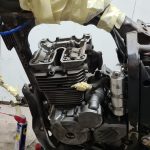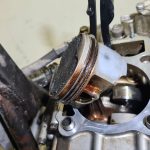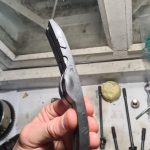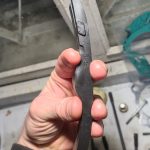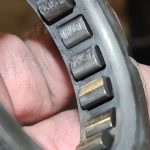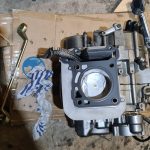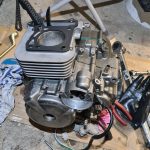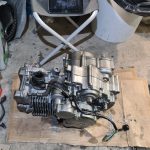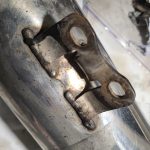(to prevent "Daily GeoIP Database Download Limit Reached" error :-) )
Author: writer
Bat script for rename gopro files
@echo off
echo.
echo Changing file number position in GoPro filenames
echo like this: GXXXYYYY*.* ^<-^> YYYYGXXX*.*
setlocal enabledelayedexpansion
echo.
for /f "delims= eol=:" %%f in ('dir /b /a-d G???????*.* ????G???*.*') do (
set filename=%%~nf
set firstfour=!filename:~0,4!
set secondfour=!filename:~4,4!
echo %%f ^> !secondfour!!firstfour!!filename:~8!%%~xf
ren %%f !secondfour!!firstfour!!filename:~8!%%~xf
)
echo.
echo Done.
pause
[fix] mongodump fails after upgrade mongodb to 5.0 (error counting admin.system.new_users)
This recipe will help if you got error like this:
Failed: error creating intents to dump: error creating intents for database admin: error counting admin.system.new_users: (Unauthorized) not authorized on admin to execute command { count: "system.new_users"
The one working workaround at this time is (if we using in mongodump user "admin"):
db.createRole({
role: 'mongodump_fix_role',
privileges: [ { resource : { "db" : "admin", "collection" : "system.new_users" }, actions: [ "find" ] }],
roles: []
})
db.grantRolesToUser("admin", [{ role: "mongodump_fix_role", db: "admin" }])
More info: https://www.mongodb.com/community/forums/t/dropping-admin-system-new-users-collection/219435
Капиталка Suzuki Djebel
В конце 22го года таки занялся капиталкой двигла.
Трошечки фоточек сего занимательного процесса:
Bye-bye XRюшка
На той неделе продал XR150.
Хрюшка - быда моим первым мотыком, и я думал шо никогда не захочу её продавать.
Ага, щас)
После джебеля и ДРки - он уже неедет.И подвески нема :-)
А после того, как моя девушка, которая раньше каталась со мной на этой XR'ке, купила себе CRF300 - хрюндель стал не нужен.
Так что хрюшка была без сожалений продана, и поехала радовать новых хозяев в Киев.
А я, чуть пожжи, накатаю постик, в котором распишу биографию всех мотыков, которые у меня есть/были.
Пушо, как минимум у трёх из них - есть своя интересная история.
Днепр. 20230114
Ебучая русня принесла ебучий русский мир.
На мой родной жилмассив, где я вырос.
Convert the public key format from SSH2 to OpenSSH
ssh-keygen -i -f ssh2.pub Поменял пево на 3г момед
На днях второй раз в жизни произвел натуральный обмен на пево :-)
В этот раз выменял 3G модемчик, шоб поиграться с резервным каналом связи.
Прошлый раз подобный обмен был лет 10 назад, тогда я материнку с процом у тогдашнего сенсея выменял на пивчанский :-)
Using chroot
--rbind, some subdirectories of dev/ and sys/ will not be unmountable. Attempting to unmount with umount -l in this situation will break your session, requiring a reboot. If possible, use -o bind instead.In the following example, /location/of/new/root is the directory where the new root resides.
First, mount the temporary API filesystems:
# cd /location/of/new/root # mount -t proc /proc proc/ # mount -t sysfs /sys sys/ # mount --rbind /dev dev/
And optionally:
# mount --rbind /run run/
If you are running a UEFI system, you will also need access to EFI variables. Otherwise, when installing GRUB, you will receive a message similar to: UEFI variables not supported on this machine:
# mount --rbind /sys/firmware/efi/efivars sys/firmware/efi/efivars/
Next, in order to use an internet connection in the chroot environment, copy over the DNS details:
# cp /etc/resolv.conf etc/resolv.conf
Finally, to change root into /location/of/new/root using a bash shell:
# chroot /location/of/new/root /bin/bash
chroot: cannot run command '/usr/bin/bash': Exec format error, it is likely that the architectures of the host environment and chroot environment do not match.chroot: '/usr/bin/bash': permission denied, remount with the execute permission:mount -o remount,exec /location/of/new/root.
After chrooting, it may be necessary to load the local bash configuration:
# source /etc/profile # source ~/.bashrc
# export PS1="(chroot) $PS1"
When finished with the chroot, you can exit it via:
# exit
Then unmount the temporary file systems:
# cd / # umount --recursive /location/of/new/root
umount: /path: device is busy, this usually means that either: a program (even a shell) was left running in the chroot or that a sub-mount still exists. Quit the program and use findmnt -R /location/of/new/root to find and then umount sub-mounts. It may be tricky to umount some things and one can hopefully have umount --force work. As a last resort, use umount --lazy which just releases them. In either case to be safe, reboot as soon as possible if these are unresolved to avoid possible future conflicts.Техническое по Honda XR150 (личные заметки + база знаний из интернетов)
Тут собрана некоторая кучка знаний по этому мотыку.
...continue reading "Техническое по Honda XR150 (личные заметки + база знаний из интернетов)"
